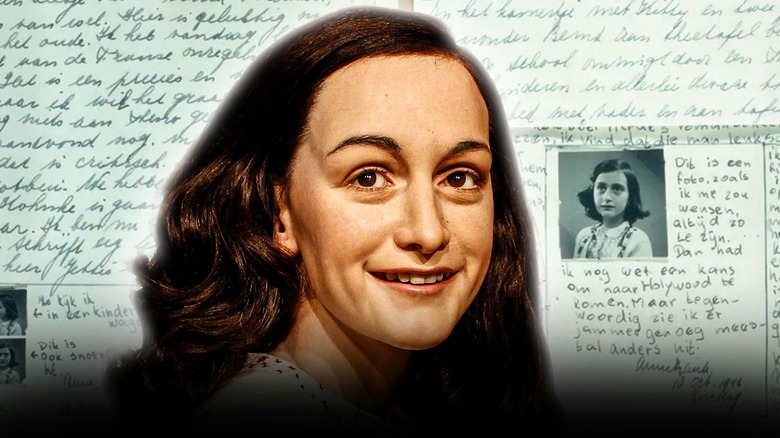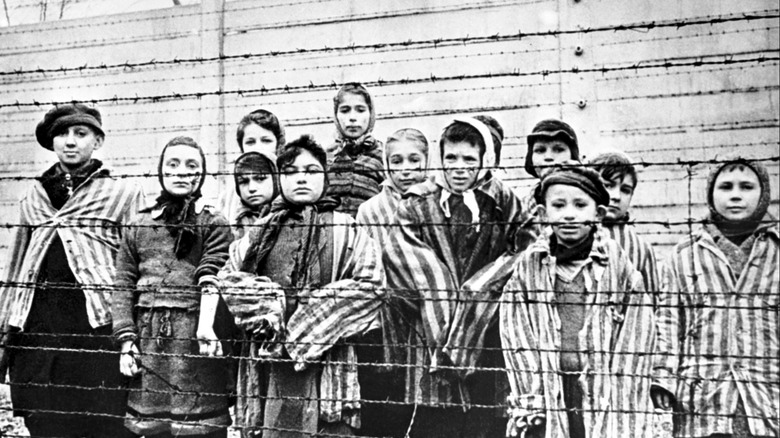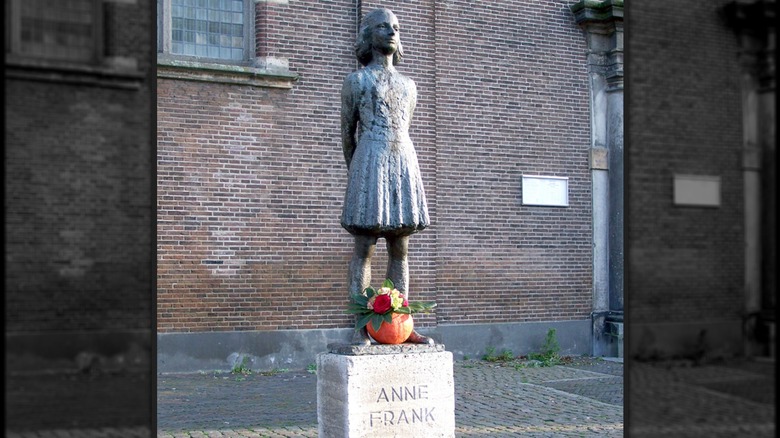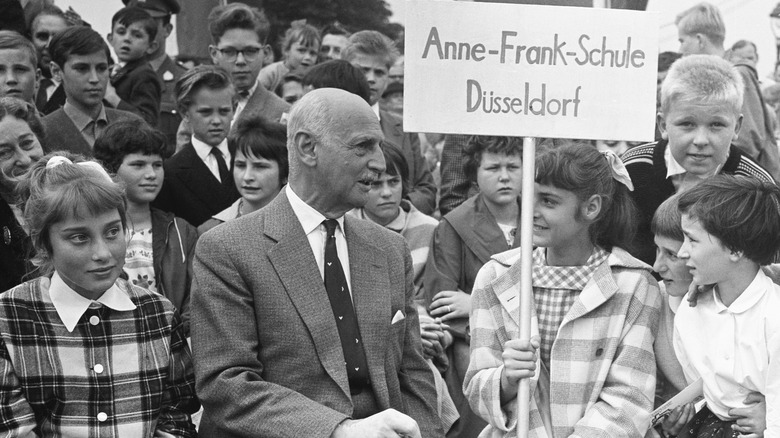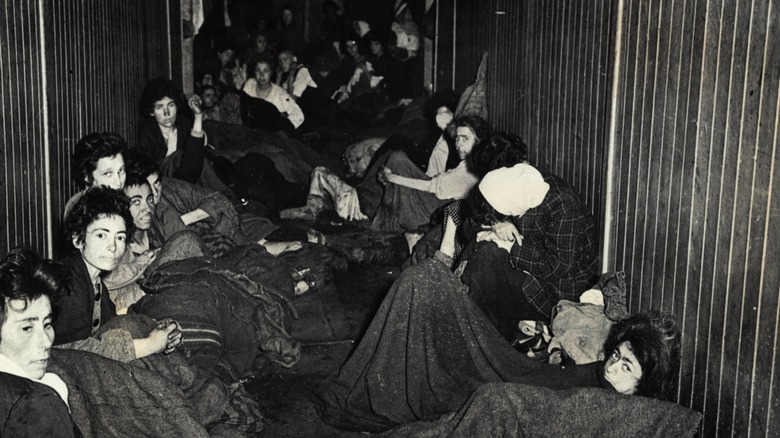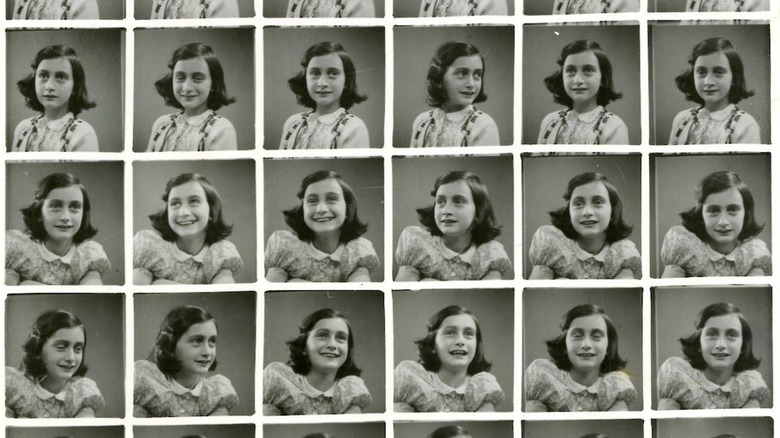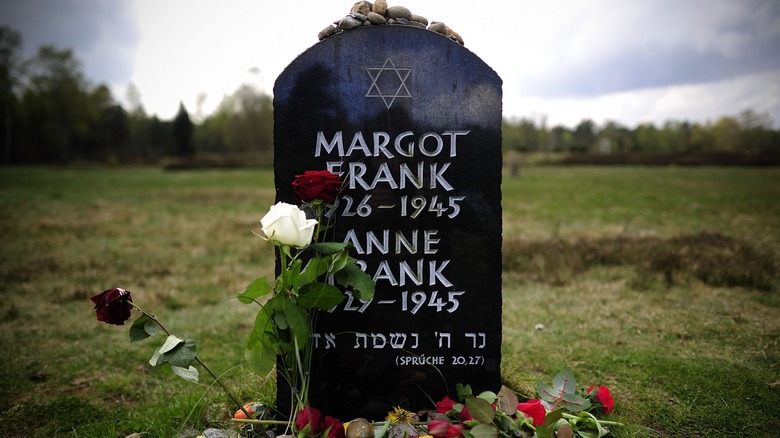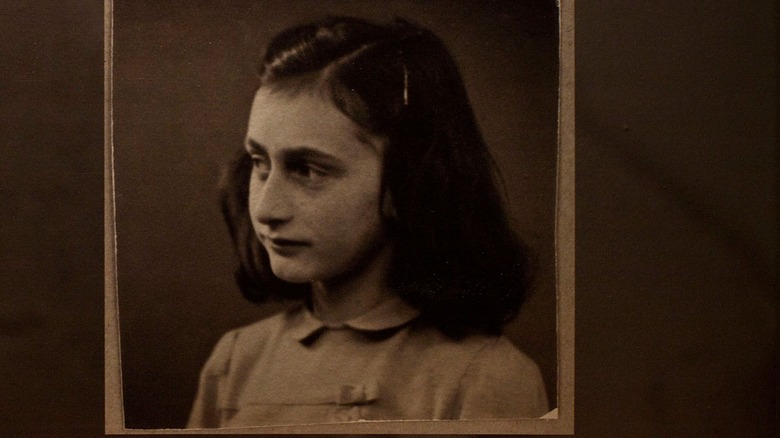The Final Months Of Anne Frank
We may receive a commission on purchases made from links.
Born on June 12, 1929, in Frankfurt, Germany, Anne Frank was truly one of the most inspiring and important people in modern history. Frank grew up during the reign of Adolf Hitler and his sadistic Nazi government, and she was forced to live most of the final years of her life tucked away in an attic in Amsterdam, hiding with her family. They stayed there for over two years until the Nazis discovered them in August 1944.
Though the Nazis murdered her in 1945 at the Bergen-Belsen concentration camp, her story continues to live on today as a potent symbol of the resilience displayed by the Jewish people during the Holocaust and World War II. Frank originally came to prominence in the United States in the 1950s, following the publication of the diary she had kept while in the Amsterdam attic. The book has since become one of the greatest bestsellers in history, and is required reading in many classrooms around the country.
Unfortunately, due to the circumstances of her death, it's unknown exactly which day she died in 1945. For decades, it was thought that both Frank and her sister passed sometime in March 1945 due to typhus. However, newer research indicates that it may instead have been closer to February when they both succumbed to illness. We don't know a lot about Frank's final days, and the little bit we do is largely from eyewitness accounts, which paint a horrifying and tragic picture.
[Image by Hansmuller via Wikimedia Commons | Cropped and scaled | CC BY-SA 4.0]
Anne was hopeful before being arrested
When Anne Frank was only 13 years old, she had to start hiding in an attic to escape the Nazis. That was in July 1942, and the month prior, her father gave her a diary for her birthday, which she started using immediately. She did not journal in the diary every single day, but she did write quite frequently considering her conditions at the time. Her entries display not only her vulnerability and understanding of the horrifying reality she was enduring, but also show that even in her captivity, she was still able to learn a good deal about what was happening.
Her family had access to a radio in the attic, which they could tune in to the BBC transmissions from England, and that helped keep them apprised about some of what was going on outside their confined walls. In one of her more poignant entries from June 6, 1944, Frank wrote about the D-day offensive being launched by the Allies in France, which made her hopeful about the possibility of leaving the annex and returning to school within a few months.
In her penultimate entry on July 21, 1944, she showed she was aware of the July 20 plot on Adolf Hitler's life, which made her confident that the war and Holocaust would soon be over. Her final journal entry was on August 1, and she was placed under arrest on August 4, 1944 by Nazi authorities.
Anne arrived at the Bergen-Belsen concentration camp in October
Anne Frank and her family were arrested on August 4, 1944 by the Nazis, and just a few months later, she would reach her final destination at the Bergen-Belsen concentration camp, where she would ultimately perish. After arresting them, the Nazis sent the Frank family first to a prison camp and then a detention center, and on September 3, 1944, they were part of a group of just over 1,000 Jewish men, women, and children, who were sent to the infamous Auschwitz-Birkenau death camp.
While at Auschwitz, Anne lived under constant threat of being sent to the gas chambers, and their living conditions were predictably appalling. The Nazis provided them with little food and water, not even enough to really survive, and Anne ended up coming down with scabies due to the filth. Her sister Margot Frank helped to take care of her, and they were also with their mother, Edith Frank, though they were separated from their father, Otto Frank.
While Anne was still sick, the Nazis took both her and Margot from Auschwitz on October 28, 1944, and sent them to Bergen-Belsen. While Bergen-Belsen was not an extermination camp like Auschwitz, by the time the Franks got there, conditions had devolved so much that inmates were constantly dying of sickness and disease. Sadly, by the time the Allies would finally liberate Bergen-Belsen months later, both Margot and Anne would be dead from illnesses they contracted due to the unsanitary conditions.
Anne had bittersweet reunions
When Anne Frank arrived at the concentration camps in 1944, she was reunited with many of her old friends from before her family had gone into hiding. One of them was Hannah Pick-Goslar, a former neighbor of Frank's from her home in Amsterdam (via "The Last Seven Months of Anne Frank"). While the two were imprisoned at Bergen-Belsen, Pick-Goslar found Frank in February 1944 after getting word that she was there, and they were able to talk to each other through a barbed-wire fence. Frank was very distraught, and Pick-Goslar later gave her a small care package of things she had gotten from the Red Cross, but Pick-Goslar never saw her again after that.
Another friend Frank saw was Nanette Blitz Konig, also at the Bergen-Belsen camp (via Blitz Konig's "Holocaust Memoirs of a Bergen-Belsen Survivor"). The two had previously been classmates, and they started crying when they finally embraced each other. Konig had spotted Frank from behind the barbed-wire fence, and she went looking for her and even started shouting her name. Their first reunion was brief and bittersweet, as they both reflected on their incredible losses over the past few years. Frank told Konig about her time in Auschwitz-Birkenau, and the two dreamed about life after the Holocaust when they would be free again.
Both Konig and Pick-Goslar were also familiar acquaintances, and they survived the war to later write about their experiences with Frank. Pick-Goslar died in Israel at the age of 93.
[Image by brbbl via Wikimedia Commons | Cropped and scaled | CC BY-SA 3.0]
Anne may have thought her family was all dead
For Jewish children like Anne Frank who were deported to concentration camps during the Holocaust, undoubtedly one of the most psychologically tortuous aspects was their lack of knowledge about the fate of their family and friends. When the Nazis took Anne into custody in 1944, she had been living with — among others — her father Otto Frank (pictured above), mother Edith Frank, and sister Margot Frank, and they were all arrested together.
In September 1944, the Nazis sent the Frank family to Auschwitz-Birkenau, but only Anne and Margot were then taken on to Bergen-Belsen a month later, in October. According to Hannah Pick-Goslar in "The Last Seven Months of Anne Frank," Anne told Pick-Goslar that both of Anne's parents had died at Auschwitz. She was certain that the Nazis had gassed her father Otto to death, and she was incredibly upset about losing them. However, in her autobiography "Holocaust Memoirs of a Bergen-Belsen Survivor," Nanette Blitz Konig says instead that Anne was worried about both of her parents' fates, but that she did not know for sure whether or not they were dead when they talked.
As it would turn out, Edith would pass away at Auschwitz in January 1945, while Otto would survive through the end of the war. It was Otto who would eventually get Anne's diary published in 1947, and he would pass away himself in 1980.
Anne talked about her diary being published
As incredible as it might sound, in light of how famous it has become in the decades since her death, Anne Frank actually wanted her diary to be published. While Frank was hiding inside the secret annex, one of the few windows she had to the outside world was the use of a radio. This was well before the days of the internet or even widespread TV, so radio stations like the BBC from London, England, were one of the primary sources of news — especially for those in hiding.
Towards the end of her time in the annex, Frank heard a BBC broadcast that contained a speech from the Dutch Cabinet Minister Gerrit Bolkestein (pictured above). Bolkestein implored those who were suffering through the Nazi occupation to keep their memoirs and other written pieces that represented their struggles, in the hopes that they would one day be able to publish them as living testaments to the Holocaust and war. Frank was moved by Bolkestein's words, and she made plans to publish her diary as a book under the title "The Secret Annex."
Frank had aspirations of becoming a writer, and she was very excited about the possibility of her diary being published — even during her darkest days of imprisonment. Sadly, Frank would die in the Holocaust before getting a chance to live out her dreams, but posthumously, her diary has become one of the most important sources available on the Holocaust.
Anne and Margot helped take care of orphaned children in the camp
Around a month after Anne Frank and her sister Margot Frank were taken to the Bergen-Belsen concentration camp in October, a terrible incident occurred that sticks out even among the depravity of the Holocaust. That December, one of the imprisoned dentists at the camp, Dr. Hadassah Bimko Rosensaft, had to create a makeshift home for nearly 50 young orphaned Jewish children who had just been abandoned there by the Nazis. The children's parents were sent away to a different concentration camp, and they were left outside in the bitter cold of the northern European winter.
Had Dr. Rosensaft and the other women at Bergen-Belsen not taken care of the children, they would have almost certainly perished in the harsh conditions, and they were not the only ones. In all, there were 150 children that were cared for, and two of the caretakers included the Frank sisters, Anne and Margot. As a friend of theirs, Janny Brandes-Brilleslijper, relates in "The Last Seven Months of Anne Frank," both of them helped care for the children, even though both Anne herself and Margot were only teenagers at the time.
The caretakers would tell the kids stories and help them with basic hygiene, through haircuts and clipping their nails. Amazingly, of the 150 kids taken in, only one died, and Anne and Margot played at least a small role in their survival.
Anne took care of Margot as she was dying
If there was one solace that Anne and Margot Frank could take a bit of comfort in, following their arrest in late 1944, it was that the two of them were able to stick together during all of their family's deportations. Margot was born in 1926, and was three years older than her sister Anne. Tragically, both of them ended up contracting typhus while they were imprisoned at the Bergen-Belsen concentration camp.
According to firsthand accounts, Margot was the sicker of the two between them. She was very susceptible to the cold, which was made worse by the fact that it was the middle of a frigid winter. In addition, both her and Anne's bunk was near the ground and close to the door of their barracks, meaning they were blasted by a wave of freezing air every time someone came in or out (via Rachel von Amerongen-Frankfoorder in "The Last Seven Months of Anne Frank").
Those who saw Margot noted how increasingly skeletal and gaunt she looked as her illness became more severe, and soon she lost her strength. Eventually, when Margot became too weak to get out of bed, Anne went around to the nurses at the camp trying to get blankets and supplies to replace their lice-infested ones. Anne's care of her sister may have helped prolong her life, even if only by a few days, and it showed incredible fortitude and resilience.
Anne's living conditions were horrendous
The final camp that Anne Frank lived in, Bergen-Belsen, originally opened in 1940, but became a concentration camp in 1943. Yet, by January 1945, a few months after Frank had been transported there from Auschwitz-Birkenau, conditions at Bergen-Belsen had deteriorated to the point of near collapse. The camp was becoming exceedingly overcrowded as more prisoners came in every day, and this was compounded by hygienic and sanitary conditions, as well as a food and water shortage.
At times, the prisoners had to endure multiple days without food or water, and the guards would seemingly taunt them by leaving potentially poisoned delicacies such as mussels in the camp. Hundreds of prisoners were dying daily, too many to cremate, and bodies began piling up around the camp. This was a haven for disease, and lice and fleas infested many camp prisoners. Due to inadequate clothing, many prisoners were also subjected to frostbite in the winter conditions, and Frank's own quarters were leaky and did a poor job against the elements.
The conditions were so horrendous that when the British came to liberate the camp in April 1945, many of the soldiers refused to enter because they were too worried about catching disease. Frank and her sister were just two of the roughly 50,000 people who perished at Bergen-Belsen, both due to illnesses they contracted as a result of the filth.
Anne's sister died days before she did
When Anne and Margot Frank first arrived at the Bergen-Belsen concentration camp, they were malnourished but still mobile and able to communicate with the other prisoners. According to her autobiography "Holocaust Memoirs of a Bergen-Belsen Survivor," Nanette Blitz Konig talked with both Anne and Margot several times while they were imprisoned at Bergen-Belsen.
However, at some point the Frank sisters both got typhus and soon became incredibly ill. More than likely, they contracted the disease from body lice, which were rampant at Bergen-Belsen. Margot was sicker than Anne, as she was bedridden, while Anne was still able to leave her barracks and talk with other prisoners. Fellow prisoners at Bergen-Belsen say that Margot died before Anne did, after she fell out of her bunk and was too frail to pick herself back up. The two shared a bunk, which meant that Anne was likely just feet away from her sister when she died. If Anne was still alive and conscious, it's impossible to imagine the grief she must have felt at the loss of her sister.
Initially, the Dutch government listed Margot's death date as March 27, 1945, as they needed a singular date for official purposes. However, researchers now speculate that she passed away in February 1945, around her would-be 19th birthday, and likely only days before Anne. Sadly, this was just months before Allied forces liberated Bergen-Belsen in April 1945.
Anne Frank's death
Anne Frank's heroic story came to a tragic end at the Bergen-Belsen concentration camp when she was just 15 years old. Anne died of typhus fever from the bacteria Rickettsia prowazekii, which she probably contracted from body lice due to the camp's wretched conditions. It's unknown exactly when Anne became infected, but since it takes about 2-3 weeks for typhus to turn fatal, she more than likely became ill in either late January or early February 1945.
According to fellow prisoners like Rachel von Amerongen-Frankfoorder, who saw Anne in the months before her death, the typhus and lack of provisions were showing inescapable physical signs of decline (via "The Last Seven Months of Anne Frank”). Von Amerongen-Frankfoorder described Anne as "emaciated" and wrote "You could really see both of them [including sister Margot Frank] dying."
A few days before dying, Anne hallucinated from her severe fever, and she threw out her clothes (which were infested with lice and fleas). However, she had nothing to replace them with, leaving her to wrap herself in a single blanket as her only protection from the elements. Anne died a day or two after Margot, and about two months before liberation. Initially, her death was listed on March 31, 1945, but historians now believe it was about a month-and-a-half earlier in mid-February. Either way, her legacy continues to live on decades later as an inspiration to millions, and as a tragic reminder of the horrifying atrocities of the Holocaust.
